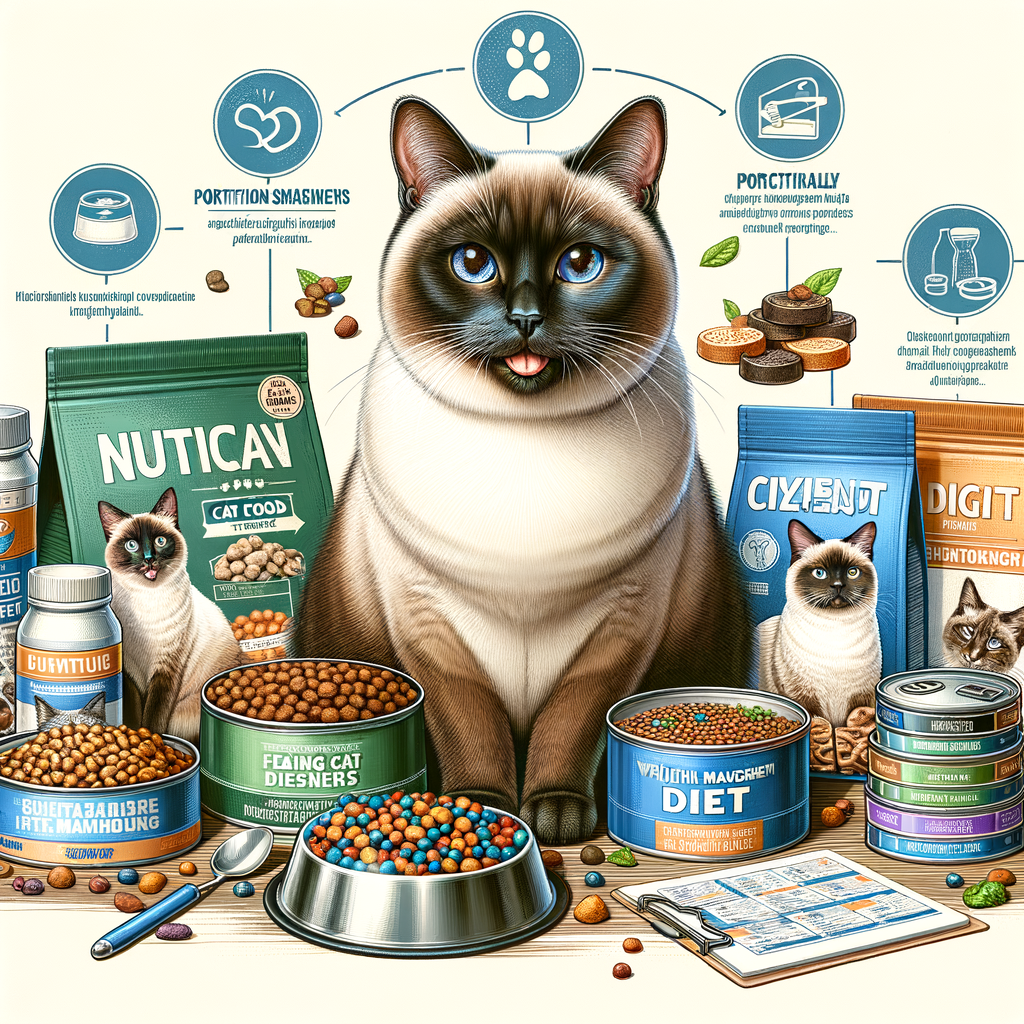
Introduction to Siamese Cat Weight Management
Managing the weight of your Siamese cat is an essential part of ensuring their overall health and longevity. This introductory guide will provide you with the necessary knowledge and tools to maintain your Siamese cat’s weight effectively.
- The Importance of Weight Management for Cats
- Specific Challenges with Siamese Cat Weight Control
Weight management plays a crucial role in a cat’s overall health. Overweight cats are more likely to develop serious health problems, such as diabetes, arthritis, and heart disease. In contrast, underweight cats may be suffering from malnutrition or underlying health issues. Therefore, maintaining a healthy weight is key to your cat’s longevity and quality of life.
Siamese cats, in particular, face unique challenges in weight control. They are known for their high energy levels and fast metabolism, which can make it difficult to maintain a balanced diet. Additionally, Siamese cats are prone to certain genetic conditions that can affect their weight, such as Progressive Retinal Atrophy (PRA) and Feline Lower Urinary Tract Disease (FLUTD). These factors make it especially important for Siamese cat owners to monitor their cat’s weight and consult with a veterinarian regularly.
In the following sections, we will delve deeper into understanding Siamese cat nutrition, provide a guide on feeding your Siamese cat, recommend the best weight management products, and share successful weight loss case studies. By the end of this guide, you will be well-equipped to manage your Siamese cat’s weight effectively and ensure their long-term health.
Understanding Siamese Cat Nutrition
When it comes to maintaining the health of your Siamese cat, understanding their nutritional needs is crucial. Just like humans, cats require a balanced diet to stay fit and healthy. Let’s delve into the key nutrients that are vital for a healthy Siamese cat.
Key Nutrients for a Healthy Siamese Cat
There are four main nutrients that your Siamese cat needs to thrive. These are:
- Protein: Protein is a vital nutrient for all cats, including Siamese. It helps in tissue repair and muscle growth. Cats are carnivores by nature, and their bodies are designed to digest and utilize protein efficiently. A diet rich in high-quality animal protein can help your Siamese cat maintain a healthy weight and lean muscle mass.
- Fats: Fats are an essential source of energy for cats. They also help in the absorption of certain vitamins. Omega-3 and Omega-6 fatty acids, in particular, are beneficial for maintaining a healthy skin and coat.
- Carbohydrates: While cats don’t require a lot of carbohydrates in their diet, some amount can provide them with additional energy. However, it’s important to ensure that the carbohydrates in your cat’s diet come from high-quality sources like whole grains and vegetables.
- Vitamins and Minerals: Vitamins and minerals play a crucial role in various bodily functions. For instance, calcium and phosphorus are needed for strong bones and teeth, while vitamin A is essential for good vision.
By ensuring that your Siamese cat’s diet is balanced and contains these key nutrients, you can help them stay healthy and vibrant. Remember, every cat is unique, and their nutritional needs may vary based on factors like age, activity level, and health status. Therefore, it’s always best to consult with a vet or a pet nutrition expert when planning your cat’s diet.
Common Nutritional Problems in Siamese Cats
Siamese cats, like any other pet, require a balanced diet to remain healthy. However, they can face some common nutritional problems. Let’s discuss these issues and how they can impact your Siamese cat’s health.
- Obesity
- Malnutrition
- Food Allergies
Obesity is a common problem in Siamese cats. It can occur when your cat consumes more calories than it burns. This can lead to a range of health issues, including diabetes, heart disease, and arthritis. It’s crucial to monitor your cat’s weight and ensure they’re getting enough exercise.
On the other end of the spectrum, malnutrition is another issue that can affect Siamese cats. This happens when your cat isn’t getting the necessary nutrients from their diet. Symptoms of malnutrition can include weight loss, dull coat, and lethargy. It’s important to provide your cat with a balanced diet that includes all the necessary nutrients.
Siamese cats can also suffer from food allergies. These can cause a variety of symptoms, including skin irritation, digestive problems, and respiratory issues. If you suspect your cat has a food allergy, it’s important to consult with a vet. They can help identify the allergen and recommend a suitable diet.
Understanding these common nutritional problems can help you take better care of your Siamese cat. Remember, a healthy diet is key to a happy and healthy cat.
Siamese Cat Feeding Guide
Feeding your Siamese cat properly is crucial for its health and well-being. This guide will help you understand how much and when to feed your Siamese cat.
How Much to Feed Your Siamese Cat
Knowing the right amount of food to feed your Siamese cat can be a bit tricky. It depends on various factors such as their age, weight, and overall health. Here are some general guidelines:
- Feeding based on age:
Kittens require more food per pound of body weight to support their growth than adult cats. They usually start with about a quarter cup of dry food per meal and gradually increase as they grow. Adult Siamese cats, on the other hand, require less food. A typical adult Siamese cat requires about half a cup of high-quality dry cat food per day.
- Feeding based on weight:
Overweight Siamese cats require a special diet to help them lose weight safely. If your cat is overweight, you should consult your vet for a personalized feeding plan. On the other hand, underweight cats may need more food or a special diet to help them gain weight. Always consult your vet if you’re unsure about your cat’s dietary needs.
Remember, these are just guidelines. Every Siamese cat is unique and may have different nutritional needs. Always consult with your vet to determine the best feeding plan for your cat.
When to Feed Your Siamese Cat
Feeding your Siamese cat at the right times can greatly contribute to their overall health and well-being. Here are the best times to feed your feline friend:
- Morning Feeding
- Afternoon Feeding
- Evening Feeding
Start your cat’s day with a nutritious meal in the morning. This is when their metabolism is at its peak after a long night’s rest. A meal at this time provides the energy they need to stay active and playful throughout the day. It’s best to feed them between 7:00 AM and 9:00 AM.
Siamese cats, like most felines, tend to have a rest period in the afternoon. A light meal around 1:00 PM to 3:00 PM can help replenish their energy levels for the rest of the day. Remember, this meal should be smaller than the morning meal to prevent overeating.
The final meal of the day should be around 6:00 PM to 8:00 PM. This meal helps your cat feel satisfied throughout the night, reducing the chances of midnight snacking. Make sure this meal is balanced and nutritious to promote good health and weight management.
Remember, every Siamese cat is unique and may have different feeding needs. Always monitor your cat’s eating habits and adjust feeding times as necessary to ensure they are getting the nutrition they need.
Best Cat Weight Management Products
When it comes to managing your Siamese cat’s weight, the right food products can make a significant difference. Here are some of the top-rated healthy cat foods that have been proven to aid in weight control.
Top Rated Healthy Cat Food for Weight Control
- Purina Pro Plan Weight Management Formula: This product is specially formulated to help cats maintain a healthy weight. It’s high in protein to support lean muscle mass and contains 20% less fat than Purina Pro Plan Savor Adult Chicken & Rice Formula.
- Hill’s Science Diet Perfect Weight Dry Cat Food: This clinically proven nutrition can help your cat achieve a healthy weight and improve quality of life. It’s made with real chicken as the #1 ingredient and contains no artificial colors, flavors, or preservatives.
- Blue Buffalo Weight Control Natural Adult Dry Cat Food: This product features real meat as the first ingredient, wholesome whole grains, garden veggies, and fruit. It also contains LifeSource Bits, a precise blend of antioxidants, vitamins, and minerals selected by holistic veterinarians and animal nutritionists.
Remember, every cat is unique and may require different nutritional needs. Always consult with your vet before making any changes to your cat’s diet.
Effective Cat Diet Products for Weight Loss
When it comes to managing your Siamese cat’s weight, choosing the right diet products is crucial. Here are three effective diet products that can help your cat lose weight safely and healthily.
- Product A: Calorie-Controlled Wet Cat Food
- Product B: High-Protein Dry Cat Food
- Product C: Weight Management Cat Treats
Wet cat food is often a good choice for weight control because it’s typically lower in calories and higher in protein than dry food. Product A is a calorie-controlled wet cat food that’s specially formulated to help cats lose weight. It’s packed with lean protein and low in fat, which can help your cat feel full without overeating.
Product B is a high-protein, low-carb dry cat food that’s designed to help cats lose weight. The high protein content helps maintain muscle mass during weight loss, while the low carbohydrate content can help reduce overall calorie intake. Plus, it’s made with real meat, so it’s not only nutritious but also delicious for your cat.
Even when your cat is on a diet, it’s still important to reward them with treats. Product C is a weight management cat treat that’s low in calories but high in taste. These treats are made with real chicken and are free from artificial colors, flavors, and preservatives. They’re a great way to reward your cat without contributing to weight gain.
Remember, when introducing new diet products to your cat’s routine, it’s important to do so gradually to avoid upsetting their stomach. Always consult with your vet before making any major changes to your cat’s diet.
Case Studies: Successful Siamese Cat Weight Loss
Let’s delve into some real-life examples of Siamese cats that have successfully achieved and maintained a healthy weight. These case studies will provide you with practical insights and strategies that have proven effective.
-
Case Study 1: Bella’s Journey
Bella, a 5-year-old Siamese, was significantly overweight at 15 pounds. Her owner, Mrs. Johnson, decided to take action by implementing a strict feeding schedule and switching Bella to a high-protein, low-carb diet. After 6 months, Bella had lost 3 pounds and was more active and playful. This case study underscores the importance of a balanced diet and regular feeding times.
-
Case Study 2: Max’s Transformation
Max was a 7-year-old Siamese cat weighing 18 pounds. His owner, Mr. Smith, introduced a combination of dietary changes and increased physical activity. Max was transitioned to a weight management cat food and played with interactive toys for at least 20 minutes each day. After a year, Max had lost 5 pounds. This case highlights how a combination of diet and exercise can significantly improve a cat’s health.
-
Case Study 3: Lily’s Success Story
Lily, a 4-year-old Siamese, was 14 pounds when her owner, Ms. Davis, decided to consult with a veterinarian. The vet recommended a specialized weight management diet and regular check-ups to monitor Lily’s progress. Within 8 months, Lily had lost 2 pounds and maintained a steady weight thereafter. This case study emphasizes the value of professional advice and regular health checks in managing a cat’s weight.
These case studies demonstrate that with the right approach, it’s entirely possible to help your Siamese cat achieve a healthy weight. Remember, every cat is unique, so what works for one might not work for another. It’s always best to consult with a veterinarian before making significant changes to your cat’s diet or lifestyle.
Conclusion: Maintaining Your Siamese Cat’s Health
As we wrap up this comprehensive guide on Siamese cat health, let’s summarize the key points we’ve discussed. Remember, the goal is to keep your Siamese cat healthy, happy, and active for as long as possible.
- Key takeaways for Siamese cat weight management
- Importance of regular vet check-ups
Weight management is crucial for your Siamese cat’s overall health. A balanced diet, portion control, and regular exercise are the three pillars of effective weight management. Remember, obesity can lead to severe health issues like diabetes, heart disease, and arthritis. Therefore, monitor your cat’s weight regularly and make necessary adjustments to their diet and exercise routine.
Regular vet check-ups are essential to detect any potential health issues early. Your vet can provide valuable advice on diet, exercise, and overall care based on your Siamese cat’s age, weight, and health condition. Regular vaccinations and preventive treatments for parasites are also crucial to keep your cat healthy.
In conclusion, maintaining your Siamese cat’s health requires a combination of a balanced diet, regular exercise, and routine vet check-ups. By following these guidelines, you can ensure your Siamese cat leads a long, healthy, and happy life.
| Key Health Aspects | Guidelines |
|---|---|
| Weight Management | Monitor weight regularly, ensure a balanced diet and regular exercise |
| Vet Check-ups | Schedule regular vet visits for vaccinations, preventive treatments, and health checks |








